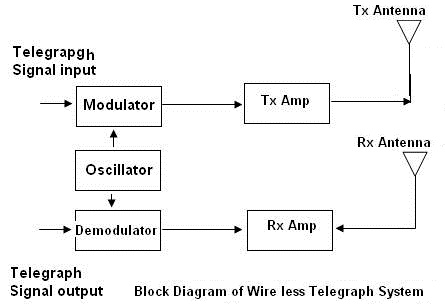Wireless Telegraphy
At the transmitter side, when the key is pressed, the telegraph signal current passes through the modulator, where high frequency signal from the osc is also received. The two are mixed and then- after passing through amplifier, the antenna radiates power in the air and is received by the distant receiving antenna. At the receiver side the signal received, after passing through amplifier, is demodulated and is again converted into telegraph signals.
The functions of the various blocks- in the block diagram are as follow,

MODULATOR
The modulator is a circuit, which combines or mixes two frequencies. The telegraph signal, which is a low frequency signal and a carrier, which is a high frequency signal are mixed in the modulator. Both frequencies appear as modulated signal at the output of the modulator. The modulated signal-is a high frequency signal and is more suitable for transmission.
Demodulator
The demodulator is an essential part of the receiver. It does the reverse function as that of the modulator. The original telegraph signal is separated from the carrier signal by the demodulator circuit.
Amplifier
The amplifier is used to amplify the power level of the signal to a sufficient amount. The transmitting amplifier boosts the signal power level more suitable for transmission. The receiving amplifier raises the power level of the received signal to an adequate amount.
Oscillator
The oscillator is a circuit, which generate radio frequency signal called carrier. At the transmitter side the carrier signal is mixed with the signal containing information and thus resulting in a high frequency modulated wave suitable for transmission. At the receiver side the output of the oscillator is used to select the required signal from the various radio frequency signals picked up by the antenna and reject all others.
